Swine Diseases
Learn about a variety of swine dieases and how to identify them
The US is one of the leading producers of pork in the world contributing immensely to the US gross income. Every year the US swine industry loses a significant amount of money to diseases affecting the swine herds across the US. Understanding a disease is important to defend against disease. This section comprises information to help you better understand and identify some of the most catastrophic swine diseases that either pose threat or are widespread in the US swine industry.
Overview
As one of the largest swine producers and exporters in the world, the US generates over $20 billion in gross income per year. However, swine diseases cause substantial loss every year.
For example, porcine reproductive and respiratory syndrome (PRRS) and porcine epidemic diarrhea virus (PEDv) can wipe out entire herds. Foreign animal diseases like African swine fever (ASF) and food-and-mouth disease (FMD) disrupt the export market and lower the market value for infected hogs.
Disease outbreaks can also require mass depopulation of infected swine. An event like this is extremely concerning for the mental and financial health of hog producers and the industry.
The 2021 ASF outbreak in the Dominican Republic provides insight into how government institutions and organizations can minimize disease impacts. They increased border protection, strengthened disease monitoring and surveillance systems, and sped up vaccine production and stocking.
However, strict farm-level biosecurity is the most important effort the US can take to protect producers and the national economy from serious consequences of these diseases.
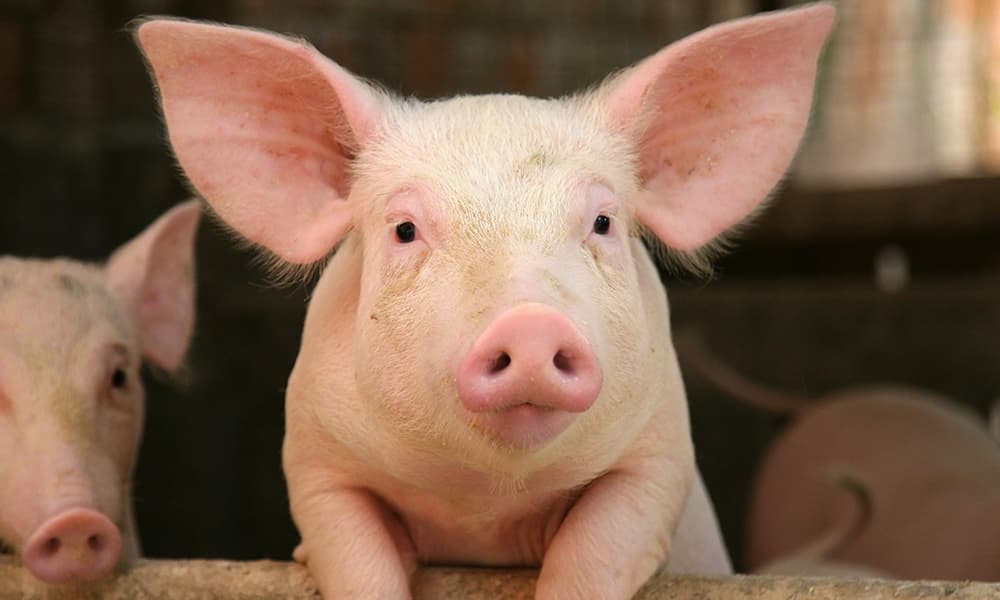
Farm-level biosecurity safeguards the herd from foreign and endemic diseases and minimizes loss as seen in the 2013 porcine epidemic diarrhea outbreak. This event took the swine industry by surprise, causing high fatality in piglets and disruptions to the supply chain.
To ensure that history does not repeat itself, producers and institutions must prepare for the worst-case scenario.
This module includes detailed descriptions of catastrophic swine diseases that either pose threat or are widespread in the US industry.
First, it is important to differentiate between a healthy and a sick pig to effectively monitor herds and intervene when necessary.
Eyes
|
|
Ear
|
|
Nose
|
|
Body
|
|
Tail
|
|
Activity
|
|
Other symptoms
|
African Swine Fever
African swine fever (ASF) is a highly contagious disease that affects pigs of all ages. Although the disease does not affect humans, it is an important disease from an economic and production standpoint.
As a foreign animal disease, ASF is not present in the US; however, 2021 ASF outbreaks in neighboring countries like the Dominican Republic have considerably heightened the risk of its transmission to the US, especially to the US Virgin Islands.
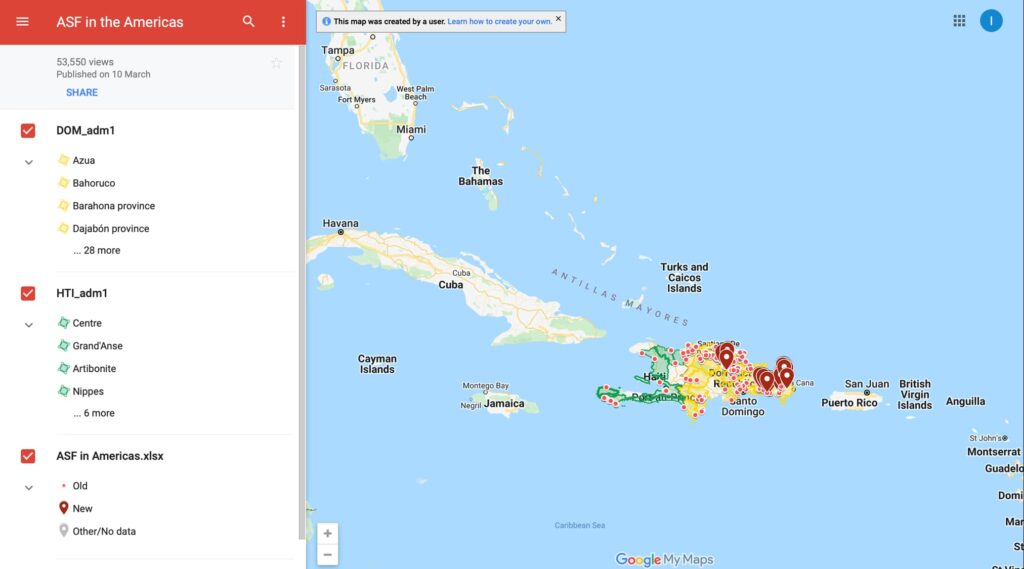
ASF’s proximity to the US has heightened the risk of an outbreak.
Currently, there is no treatment or vaccination for ASF. Once infected, the only way to control the disease is to depopulate all the exposed pigs, whether they have the disease or not.
Common Signs and Symptoms
One infected pig can infect almost all animals in the herd. The pigs die within 6-13 days after the onset of symptoms; however, sometimes pigs die suddenly without showing any symptoms of the disease.
- High fever (body temperature of 40.5ºC or 105ºF)
- Decreased appetite
- Pig appears weak
- Red blotchy skin with wounds on ears, abdomen, and legs
- Diarrhea and vomiting
- Breathing difficulty and coughing
- Pregnant sow may abort fetus
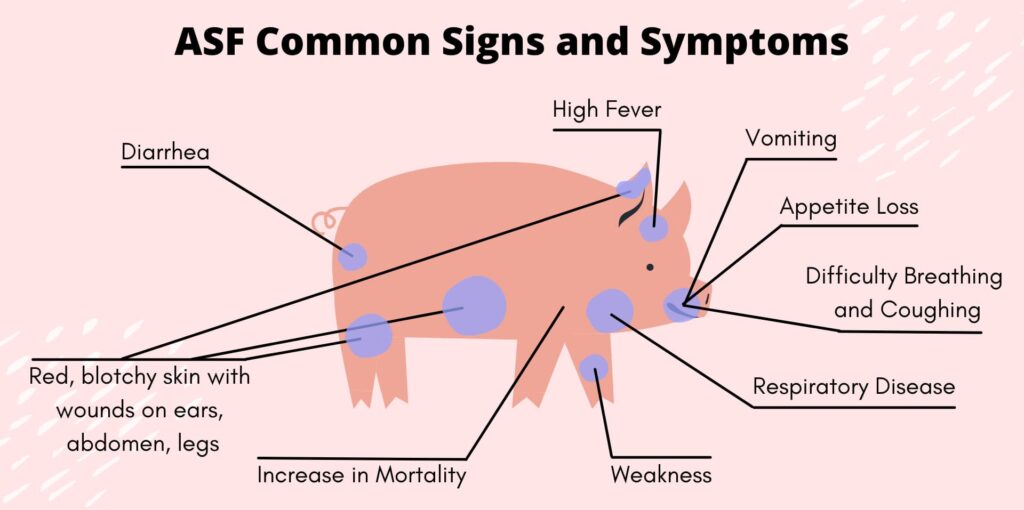
African Swine Disease common signs and symptoms.
Risk Factors
- Tick vectors present (especially soft ticks)
- Wild pigs (a disease reservoir) in the farm vicinity
- Contact with infected domestic pig
- Contact with contaminated feed, food-waste, or garbage
- Visitors (especially those with a history of foreign travel in last 1 month)
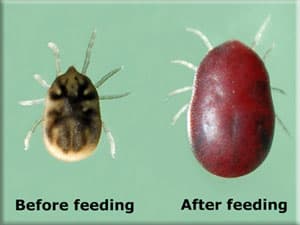
O. hermsi tick, before and after feeding. Photo taken by Gary Hettrick RML, NIAID.
How to Protect
The best way to protect the herd is to prevent them from getting infected in the first place by implementing farm-level biosecurity.
- Prevent contact with wild boars by fencing the farm and providing indoor housing
- Set up rodent and other pest control on the farm
- Monitor and control ticks and other ectoparasites
- Maintain log for visitors and permit only authorized persons onto the farm
- Do not permit visitors with a history of international travel, especially to countries with ASF
- Use a shower-in-shower-out facility for people accessing the farm
- Require farm-specific clothing and boots be worn for people accessing the farm
- Restrict between farm movement, especially in areas with multiple swine farms
- Avoid importing live pig feed for animals from regions or countries where ASF is present
- Do not feed pigs food products for human consumption, including food waste from restaurants or domestic kitchens
- Clean and disinfect equipment and transport vehicles after use
- Quarantine incoming stock
- Isolate sick pigs from healthy ones
- Buy pigs with known disease status
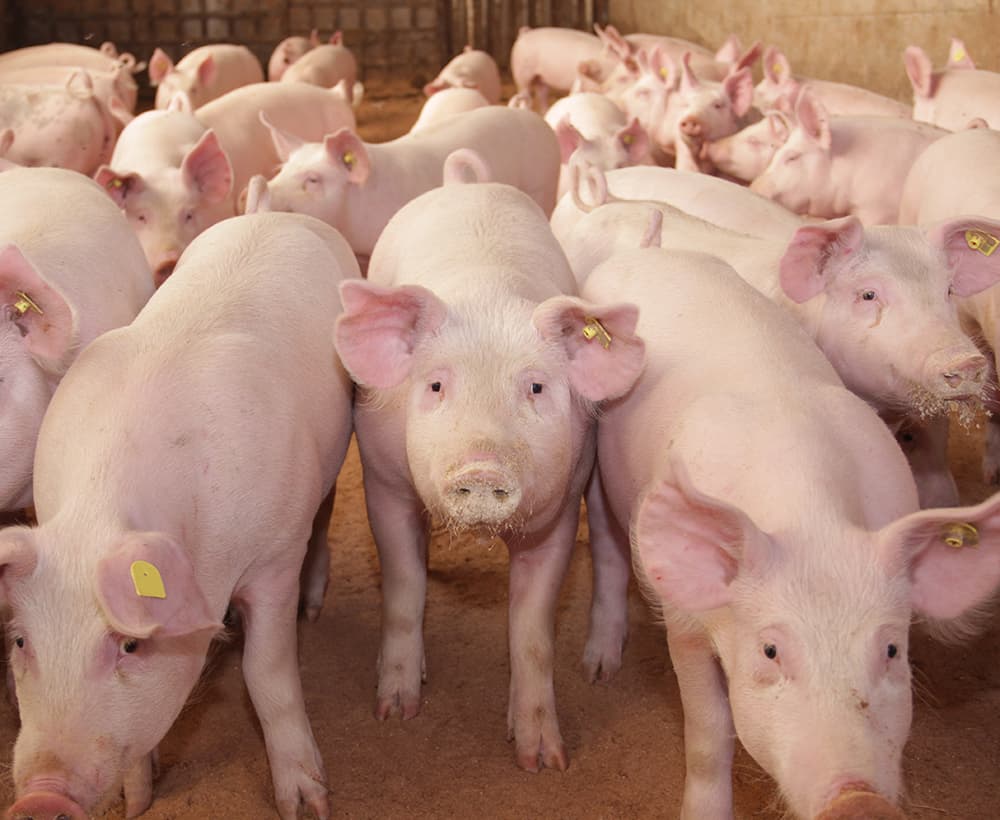
Foot and Mouth Disease
Foot and mouth disease (FMD) is a highly contagious vesicular disease. It affects a wide range of animals including pigs of all ages. FMD was eradicated from the US in 1929 but there is a risk that it will reoccur if biosecurity is compromised.
FMD is neither related to the hand, foot, and mouth disease found in humans, nor does it affect humans through direct contact or infected food.
Once FMD is introduced on a farm, it can quickly spread across multiple farms. The resulting depopulation leads to production and economic loss to the farmers. Currently, the US is free from FMD and does not vaccinate. If disease enters the US, the country will incur huge economic loss due to the export ban.
Sign and Symptoms
- Fever of 40.5ºC or 105ºF
- Sudden lameness
- Excessive salivation
- Reduced appetite
- Inactive
- Pregnant sows may abort
- Unusually high fatalities in piglets
- Vesicles or blisters on the skin, especially in claws, heels, snout, tongue, lip, and teats of recently farrowed sows; vesicles usually burst within 24 hours, causing ulcers/ erosions
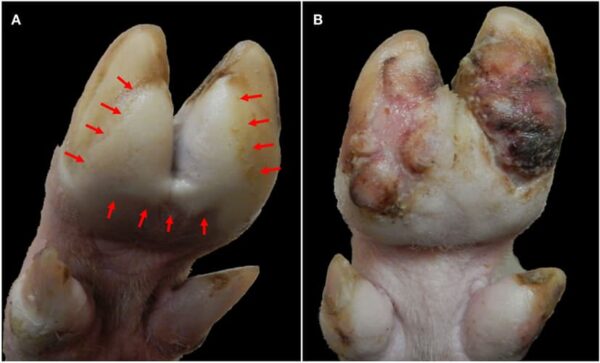
Progression of foot lesions in pig infected with foot and mouth disease. Photo by Stenfeldt et al.
Risk Factors
FMD can spread within and between pigs with the movement of infected animals or contaminated vehicles, equipment, people, and animal products. The virus can also spread by wind up to several miles or via contaminated semen. It can remain infective in animal beddings, manure, straw, and hair for a long time.

FMD can spread in many ways, including contaminated vehicles, people, other animals, and bedding, as well as by wind.
How to Protect
There is no approved treatment for FMD. Although a vaccine is present, it is only used in countries in which the disease is endemic, and it is not very effective in preventing the disease from occurring. The best protection is to prevent the herd from getting infected in the first place by implementing farm-level biosecurity.
- Prevent contact with wild pigs by fencing the farm and providing indoor housing
- Set up rodent and other pest control on the farm
- Routinely test and monitor the herd for FMD
- Consult veterinarians when suspecting signs and symptoms
- Maintain visitor log and permit only authorized persons into the farm
- Do not permit visitors with a history of international travel, especially to countries with FMD
- Set up a shower-in-shower-out system for people accessing the farm
- Require farm-specific clothing and boots be worn by people on the farm
- Restrict animal and human movement within and between farms
- Avoid importing live pig feed for animals from regions or countries where FMD is present
- Do not feed pigs food products for human consumption, including food waste from restaurants or domestic kitchens
- Clean and disinfect equipment and transport vehicles after use
- Quarantine incoming stock
- Isolate sick pigs from healthy ones
- Buy pigs with known disease status
- Clean and disinfect pens thoroughly between pig groups
Porcine Reproductive and Respiratory Syndrome
Porcine reproductive and respiratory syndrome (PRRS) is a swine disease that affects pigs of all ages. PRRS cuts production, causes reduced weight gain, breathing and breeding difficulties, and death.
It is widely prevalent in the US and substantially affects the economy, leading to an annual loss of about $560 million in the swine industry.
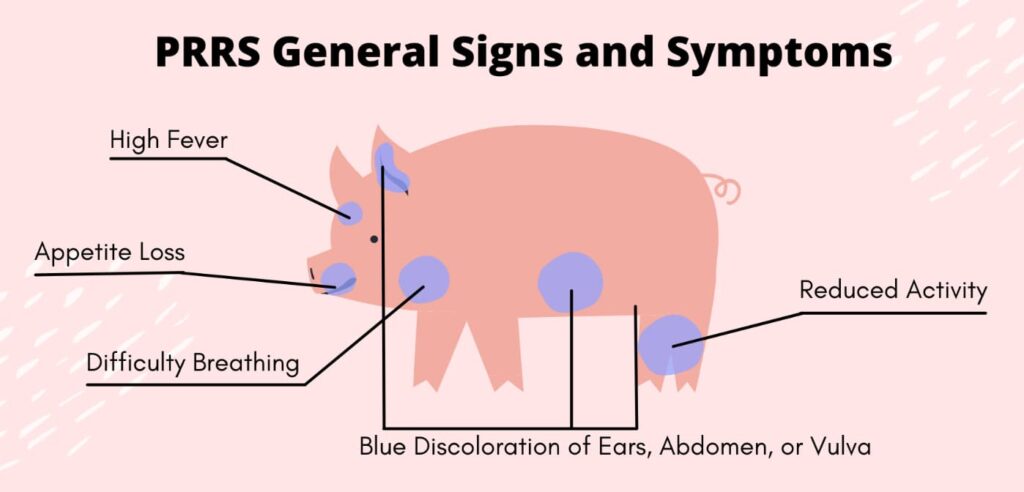
PRRS signs and symptoms. These differ based on the age and health of the pig.
Common Signs and Symptoms
Symptoms vary with the herd, its disease history, and the overall health status of the pigs.
General:
- Appetite loss
- Fever of 40.5ºC or 105ºF
- Reduced activity
- Difficulty breathing
- Blue discoloration of ears, abdomen, or vulva in sows
Breeding herd:
- Unsuccessful conception after mating sows and gilts
- Premature farrowing
- Pregnant sow may abort (usually late in term), give stillbirths, weak piglets, or mummified fetuses
- High fatalities in weaned piglets
- Reduced breeding efficiency of boars
Young, growing, and finishing pigs:
- Sneezing and coughing
- Pneumonia-like symptoms
- Stunted growth
Risk Factors
- High swine density in the area
- Large herd size
- Risky biosecurity practices on the farm
- Delayed Weaning
- Unvaccinated herd
- Farm topography
- Vehicle traffic and visitors entering the farm
How to Protect
PRRS can spread from one farm to another or from animal to animal through multiple routes, including direct contact with contaminated body fluids (urine, feces, saliva).
There is no single rule of thumb that could be used for all farm settings. Implementing robust biosecurity practices tailored for the farm and production type is the most efficient way to protect the herd.
- Vaccinate the herd
- Routinely test and monitor the herd for PRRS
- Quarantine incoming stock
- Isolate sick pigs from healthy ones
- Maintain cleanliness in animal sheds (clean, dry, warm)
- Clean and disinfect pens between stocks
- Buy pigs with known disease status
- Restrict animal and human movement within and between farms
- Restrict entry of unauthorized persons or visitors in animal shed or farm
- Set up rodent and other pest control on the farm
- Consult veterinarians when suspecting signs and symptoms
- Maintain visitor log and permit only authorized persons into the farm
- Set up a shower-in-shower-out system for people accessing the farm
- Require farm-specific clothing and boots be worn by people on the farm
- Clean and disinfect equipment and transport vehicles after use
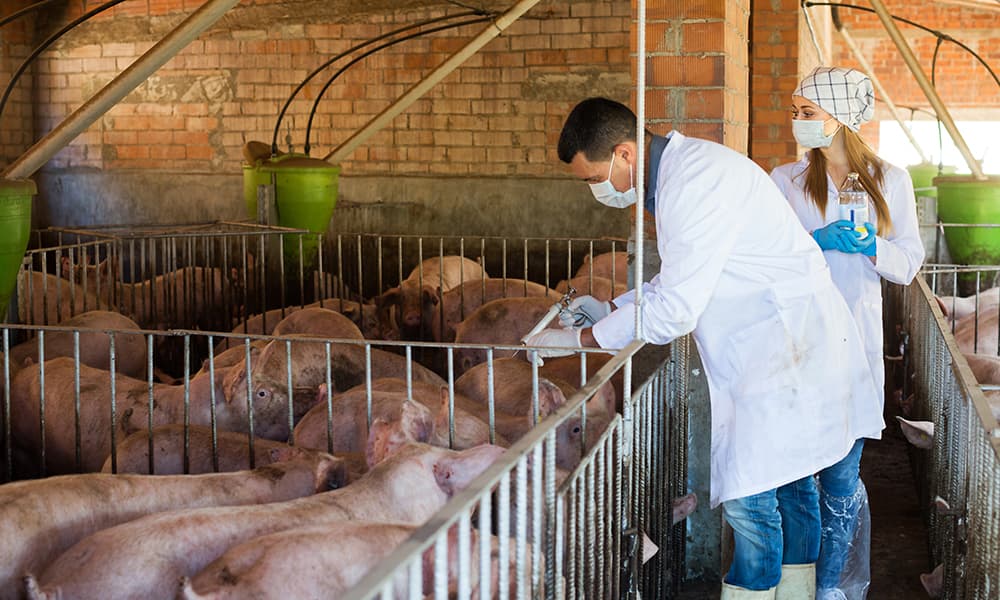
Other Endemic Diseases
In the previous section, we looked at some of the economically significant diseases that can or are causing production and financial loss to the swine production unit. However, there are many infectious diseases that affect the health and productivity of the herd.
Some of these diseases can easily transmit between animals through direct or indirect contact or through humans in close contact with sick animals. They greatly harm the animals’ health through reduced weight gain, issues with reproduction, high piglet mortality, and sores, vomiting, and other indications of bodily pain.
Possible Routes of Transmission
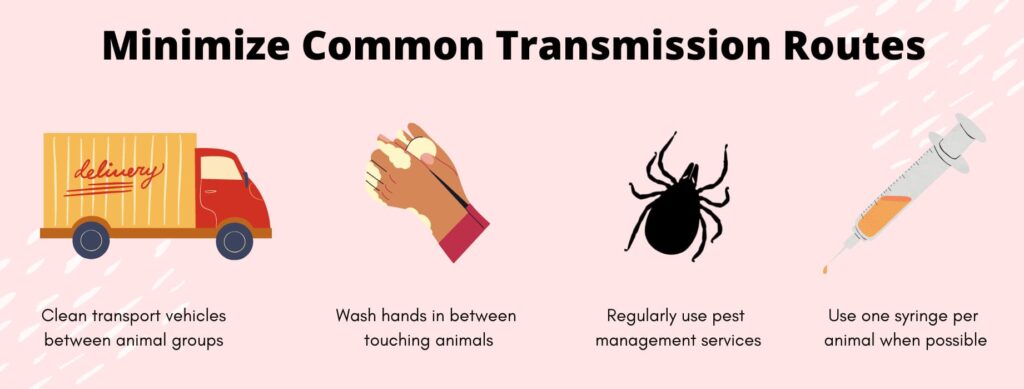
Minimize the risk of transmitting disease through direct and indirect ways.
Direct transmission (from one animal to another):
- Direct/close contact with sick animals (nuzzling, huddling)
- Bodily fluids or droplets transmitted via air (snot, eye discharge, saliva)
- Contaminated feces/urine
- Mating with sick animal
- Contaminated colostrum (sow to piglets)
Indirect transmission
- Using the same syringe on two or more animals
- Animal touching contaminated bedding
- Animal handler not washing and disinfecting hands between touching sick animals
- Contaminated/dirty transport vehicles
Vector-borne Transmission (from pests like ticks, mosquitoes, fleas)
- Ticks, mosquitoes, and fleas transmitting diseases amongst animals
What’s Next?
Now that you are familiar with some of the important swine diseases that claim millions of pigs every year, let us learn about the ways we can protect our herd against them through Biosecurity.
